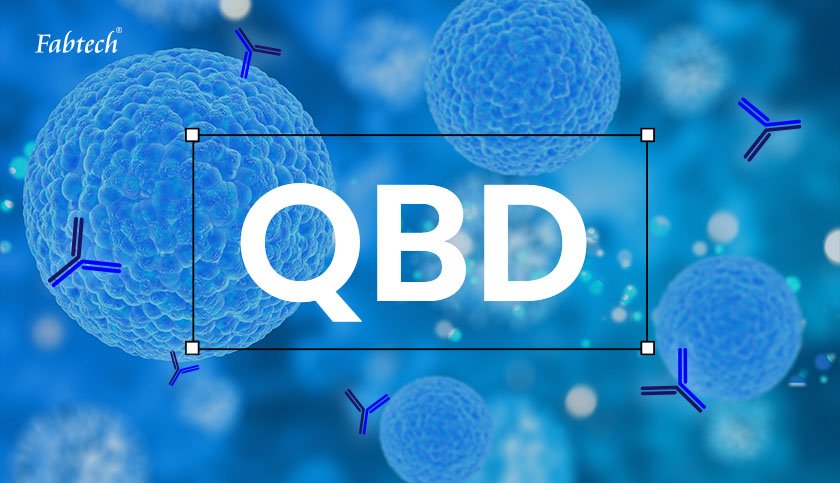Enhancing Monoclonal Antibody Development with Quality by Design

Clarity of mind is essential for executing plans effectively. This principle becomes more evident when dealing with complexities. A similar approach is taken in the pharmaceutical world, where Quality by Design (QbD) is the cornerstone of modern development processes.
QbD is a systematic developmental methodology that begins with clear objectives, integrating quality into every stage of the process rather than relying solely on end-product testing.
Before QbD was implemented, Mabs development and manufacturing were plagued with inefficiencies, resulting in limited innovation, significant product waste and a major disconnect between product attributes and manufacturing processes.
Fabtech adopts advanced QbD solutions for pharmaceuticals to transform mAb development. In this blog, we learn how QbD helps achieve breakthrough products, efficient processes and minimised variability.
Core Components of QbD in mAb Development
- Identifying Critical Steps
Identifying critical process steps in mAb development involves parameters that influence the quality and safety of the product.
- Quality Target Product Profile (QTPP) – QTPP defines the desired characteristics of the mAb, including potency, dosage form, purity, and stability. Establishing a strong QTPP foundation helps products meet therapeutic and regulatory requirements from the start.
QTPP includes critical parameters like bioavailability, strength, and compatibility with delivery methods. Revisiting and refining QTPP throughout the product lifecycle ensures alignment with evolving knowledge and requirements. - Critical Quality Attributes (CQA) – CQA are specific product attributes that impact the safety and efficacy of mAbs, such as glycosylation patterns, aggregation, and charge heterogeneity.
QbD employs advanced analytical tools, such as high-resolution chromatography and mass spectrometry, to characterise CQAs.
These attributes are monitored and controlled through predictive modelling and statistical analysis to ensure consistent quality and control. - Critical Process Parameters (CPPs) – CPPs are variables within the manufacturing process that affect CQAs. For instance, pH, temperature, and agitation during cell culture directly influence glycosylation profiles and product yield. Using the design of experiments (DoE) and multivariate analysis, QbD optimizes these parameters to enhance process robustness and minimize variability.
Read more blog:- Embarking on the Journey of Monoclonal Antibody (mAbs) Production
- Establish a Design Space
The development of a design space begins early in product/ process development, alongside the conceptualization of mAb. It defines the acceptable operating ranges for process parameters to ensure quality output. QbD creates a multidimensional framework linking CPPs to CQA.
It allows regulatory flexibility without requiring regulatory re-approval. By reducing deviations and non-conformances, mAbs offer controlled variability. Using a design space facilitates improvements while maintaining product quality.
- Host Cell Line Characterization
Biopharmaceutical manufacturing involves producing a desired product in a living host organism and relies heavily on the host cell line. Advanced QbD solutions for pharmaceuticals ensure consistent production by selecting cell lines with high productivity and favourable growth characteristics. Rigorous screening methods eliminate contaminants and maintain genetic integrity.
- Purity of Product
Purification processes in QbD use orthogonal techniques to achieve desired purity levels. This includes capturing the target product while removing impurities and separating molecules based on charge.
Filtration methods eliminate host cell proteins and other contaminants, with analytical tools verifying compliance with CQAs.
- Process Risk Assessment (PRA) and Mitigation
Risk assessment tools like Failure Mode and Effects Analysis (FMEA) and Ishikawa diagrams systematically identify potential risks in the production process.
QbD integrates risk mitigation strategies using Process Analytical Technology (PAT) to monitor CPPs and CQAs during production. It reduces equipment-related risks through predictive maintenance schedules, thus addressing the potential issues before they become critical.
Key Advantages of QbD in mAb Development
- Reduction in Variability
Variability is inherent in pharmaceutical manufacturing. QbD employs advanced statistical tools and real-time data analytics to identify and address sources of variability, such as raw material inconsistencies or environmental fluctuations. This ensures batch-to-batch consistency, reducing wastage and deviations.
- Continuous Improvement
QbD promotes a culture of continuous improvement. Data generated during production is systematically analyzed to refine processes and enhance product quality. Techniques like multivariate data analysis (MVDA) and machine learning enable predictive insights, fostering a culture of continuous improvement.
- Comprehensive Control Strategy
A robust control strategy ensures that process parameters remain within the design space to maintain product quality. A QbD control strategy integrates in-process controls (IPCs) involving real-time sampling and analysis during production. It also allows automated adjustments based on live data.
- Scaling Up and Technology Transfer
QbD provides a solid foundation for scaling up the MAb manufacturing process from early clinical production to commercial stages. By linking CPPs and CQAs, quality by design for scaling up biopharmaceutical production works well without compromising quality. The standardized processes simplify technology transfers across facilities.
- Cost Efficiency
The optimized processes reduce the likelihood of batch failures and accelerate time-to-market. Integration of PAT and automation further reduces operational costs while enhancing output quality.
Role of Fabtech in mAb Development
Fabtech is at the forefront of scientific innovations that redefine pharmaceutical excellence. Our mAb production solutions address the complexities of modern healthcare with precision and reliability.
Guided by the Quality by Design approach, we integrate high-quality mAbs into every stage of development. This fosters innovation, drives cost efficiencies, and ensures advanced therapies remain accessible.
Our expertise spans cleanroom systems, cleanroom containment, vial filling machines, capping machines, and essential facility setups.
With an in-depth understanding of antibody structure and function, we effectively implement QbD principles for biopharmaceutical process optimization to develop therapeutic mAbs that meet diverse healthcare needs.
At Fabtech, we are committed to pushing the boundaries of pharmaceutical science to deliver solutions that shape the future of healthcare excellence.
Connect with us for the best biologics manufacturing consultation for your next project.
Categories
Recent Posts
Subscribe
Never miss a post from Fabtech. Sign up to receive updates direct to your inbox.
